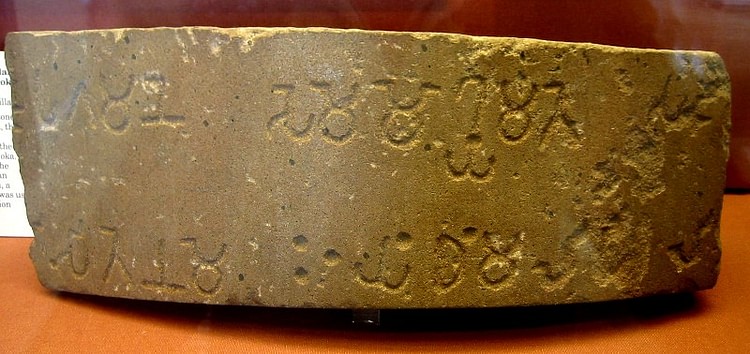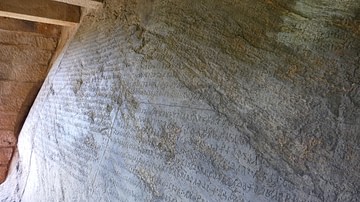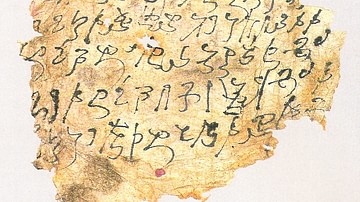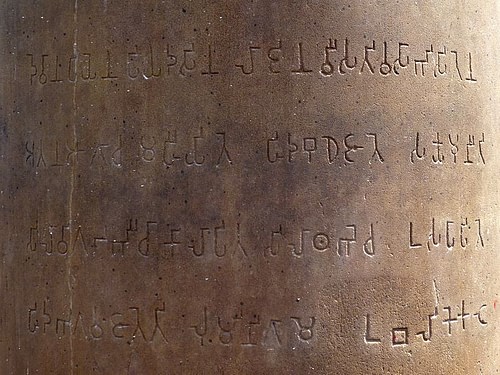
The Brahmi script is the earliest writing system developed in India after the Indus script. It is one of the most influential writing systems; all modern Indian scripts and several hundred scripts found in Southeast and East Asia are derived from Brahmi.
Rather than representing individual consonant (C) and vowel (V) sounds, its basic writing units represent syllables of various kinds (e.g. CV, CCV, CCCV, CVC, VC). Scripts that operate on this basis are normally classified as syllabic, but because the V and C component of Brahmi symbols are clearly distinguishable, it is classified as an alpha-syllabic writing system.
Origin of the Brahmi Script
One question about the origin of the Brahmi script relates to whether this system derived from another script or it was an indigenous invention. In the late 19th century CE, Georg Bühler advanced the idea that Brahmi was derived from the Semitic script and adapted by the Brahman scholars to suit the phonetic of Sanskrit and Prakrit. India became exposed to Semitic writing during the 6th century BCE when the Persian Achaemenid Empire took control of the Indus Valley (part of present-day Afghanistan, Pakistan, and northwestern India). Aramaic was the language of ancient Persian government administration, and official records were written using a North Semitic script.
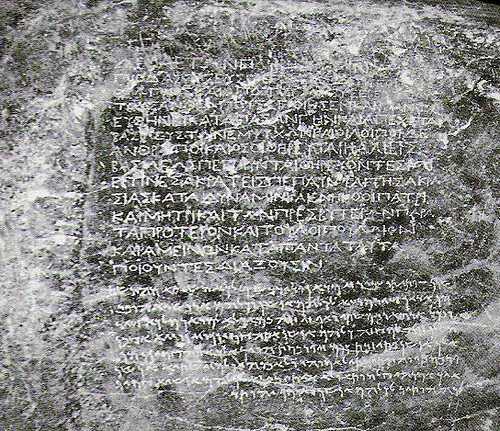
Around this time, another script also developed in the region, known as Kharosthi, which remained dominant in the Indus Valley region, while the Brahmi script was employed in the rest of India and other parts of South Asia. Although we are confident that Kharosthi is an adaptation of Semitic, the connection between Brahmi and Semitic remains unclear.
Another position has been advanced by professor K. Rajan, who has argued that the precursor of the Brahmi script is a system of symbols found on graffiti marks located on several sites in Tamil-Nadu (South India). In this region, hundreds of graffiti either inscribed or carved on potsherds and rock have been found: some of these symbols are found at the end of Brahmi inscriptions. Dilip Chakrabarti supports the connection between graffiti marks and Brahmi based on evidence found at Vallam (South India), where only graffiti inscriptions were present in the earliest phase, followed by a mix of graffiti and Brahmi script in the middle phases, and only Brahmi inscriptions in the latest periods. A similar picture has been produced by excavations at Mangudi. Whether Brahmi truly derives from graffiti is hard to confirm but the connection between the two systems cannot be ruled out.
There is a third position that claims that Brahmi derives from the Indus script, a writing system employed in the Indus Civilization which fell out of use as this civilization came to an end. Those who support this hypothesis point out the resemblance between some of the signs of these scripts. Given the complete absence of material evidence linking both writing systems, this view seems both speculative and hard to verify.
Another question about the origin of the Brahmi script relates to its antiquity. Until a few decades ago, the earliest securely dated examples available of the Brahmi script dated back to the 3rd century BCE, during the time when India was ruled by the Mauryan Empire. These examples were found on a set of royal rock inscriptions spread in North and Central India by the Indian emperor Ashoka (r. 268 BCE to 232 BCE), known as the Edicts of Ashoka or Ashokan Inscriptions.
Despite the lack of earlier examples, some scholars argued that the Brahmi script had originated earlier than the 3rd century BCE. This claim is based on the composition of a set of texts, the Brahmanas, which were attached to the Vedic literature during the 6th century BCE. The Brahmanas are the only section of the Vedic corpus written mostly in prose, unlike the earlier sections of the Vedas which are hymns for recitation, specially designed for oral transmission. The emergence of prose is hard to imagine without the support of writing technology. Further evidence comes from the work of Panini, the renowned ancient Indian grammarian who composed an influential work on grammar analysis of Sanskrit during the 5th or 4th century BCE. It is unlikely that a work like this could have been produced in a preliterate context. Knowledge of writing in India is also recorded by writers who joined Alexander the Great to India roughly a century before the time of Ashoka.
During the late 20th century CE, the notion that Brahmi originated before the 3rd century BCE gained strength when archaeologists working at Anuradhapura in Sri Lanka retrieved Brahmi inscriptions on pottery belonging to the 450-350 BCE period. The earliest of these examples are single letters, and their dates have been established through radiocarbon dating. The language of these inscriptions is North Indian Prakrit (Middle Indic), an Indo-Aryan language.
Development of the Brahmi Script
Most examples of Brahmi found in North and Central India represent the Prakrit language. The Ashokan Inscriptions already show some slight regional variations on the Brahmi script. In South India, particularly in Tamil-Nadu, Brahmi inscriptions represent Tamil, a language belonging to the Dravidian language family, with no linguistic affiliation to the Indo-Aryan languages such as Sanskrit or Prakrit.
Some Tamil examples come from inscribed potsherds found at Uraiyur (South India) dating to the 1st century BCE or the 1st century CE. In Arikamedu (South India) there is also evidence of an early form of Tamil in Brahmi inscriptions, dated to the early centuries CE. At this stage, different Brahmi characters specially adapted to suit Tamil phonetic were already in use. Examples of Tamil have not been identified among the earliest securely dated examples of Brahmi found at Anuradhapura in Sri Lanka, where the language represented is Prakrit.
By the 2nd century BCE, the Brahmi script becomes more widespread, and we can also detect the rise of marked regional variations.
Material Form & Use
Ashokan inscriptions are found on carved rocks, caves, stones slabs, and rock pillars. We also have some examples of short Brahmi inscriptions on small seals made of ivory, bone, stone, and terracotta dated to Mauryan times. Other examples come from potsherds and copper plates. With the rise of Buddhism as the dominant faith in India, we find Brahmi inscriptions on monumental constructions known as 'donative records,' stating the names of different donors. The early 2nd century BCE saw the beginning of Brahmi inscriptions on coins.
The use of perishable materials as a writing medium is an ancient widespread practice in South Asia, particularly palm leaf and birch bark. As portable and affordable writing surfaces, these materials are ideal. Direct material evidence on the use of palm leaf and birch before the time of the Ashokan Inscriptions has not been found. This lack of direct evidence could have more to do with the bias of the archaeological record due to the destruction of evidence over time rather than the actual absence of a written tradition on perishable materials. Indirect evidence of the possible use of perishable writing surfaces has been retrieved at Sringaverapura in North India in the form of traces of birch wood, from levels dated to c. 10th to 7th century BCE period. D. Chakrabarti also mentions the presence of bone items described as possible stylus employed for writing on palm leaves and birch bark, but these objects could also have been arrows.
The earliest identifiable use of Brahmi script found on ceramic surfaces was to indicate ownership of the item. Towards the mid-3rd century BCE, we see the first example of Brahmi being used for official communication in the production of seals and on the Ashokan Inscriptions. A few centuries later, Brahmi begins to be employed in religious contexts, both in architecture and for the transmission of religious texts.
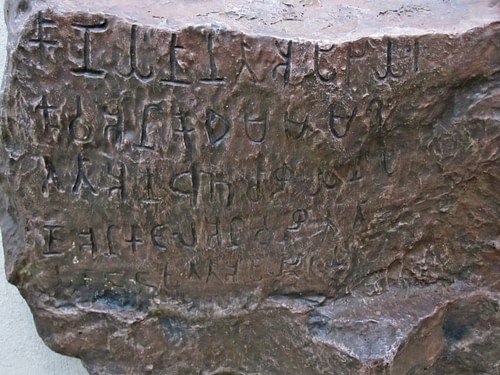
Scripts Derived From Brahmi
During its long history of development, there has been a large number of scripts derived from Brahmi. Many of the scripts derived from Brahmi have been adapted to suit the phonetic of several different languages, deriving in many script variations. The origin of numerous writing systems currently in use across Asia including the Gurmukhi, Kanarese, Sinhalese, Telugu, Thai, Tibetan, Javanese, and several others can be traced back to the Brahmi script.



